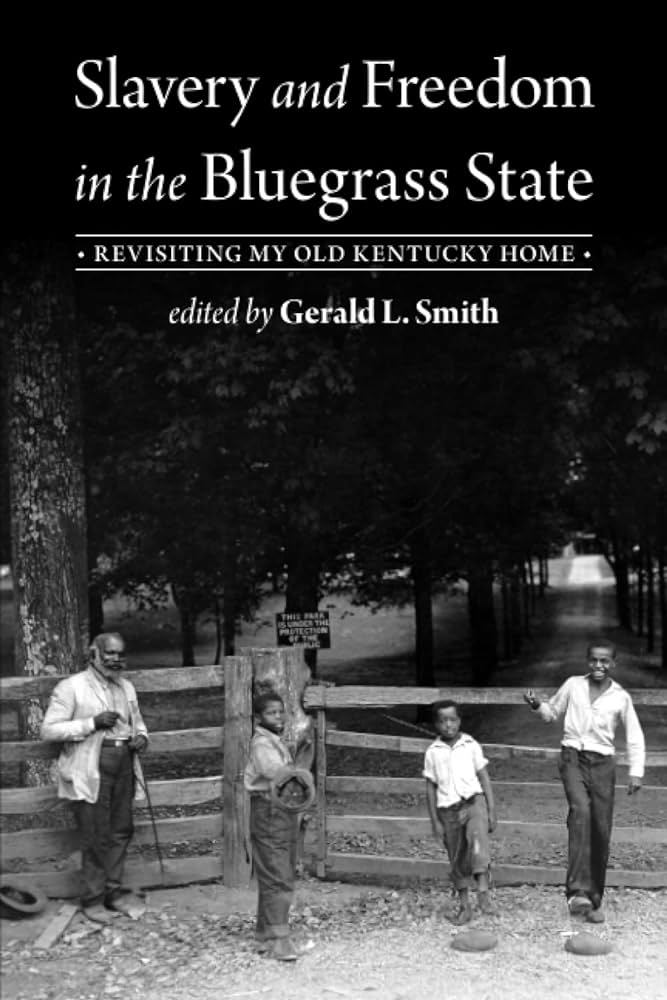Book Review: Slavery and Freedom in the Bluegrass State: Revisiting My Old Kentucky Home

 Slavery and Freedom in the Bluegrass State: Revisiting My Old Kentucky Home. Edited by Gerald L. Smith. Lexington: University Press of Kentucky, 2023. Softcover, 380 pp. $20.00.
Slavery and Freedom in the Bluegrass State: Revisiting My Old Kentucky Home. Edited by Gerald L. Smith. Lexington: University Press of Kentucky, 2023. Softcover, 380 pp. $20.00.
Reviewed by Tim Talbott
Kentucky’s African American history has a received a significant amount of scholarship over the last fifty years or so. Important studies have informed readers about the experiences of Black people in the Commonwealth from the colonial era to virtually the present, covering a wide range of topics. However, much still remains unexplored. Filling several more voids in the state’s Black history is Slavery and Freedom in the Bluegrass State: Revisiting My Old Kentucky Home, edited by Gerald L. Smith, a history professor at the University of Kentucky.
Smith, who previously co-edited the Kentucky African American Encyclopedia (2015), claims in the book’s introduction that Slavery and Freedom in the Bluegrass State “examines three broad topics: slavery, freedom, and civil rights. It addresses unanswered questions about Black life in a Border State between North and South.” (4) In doing so, it follows a historiographical trend of looking at the road traveled from enslavement to civil rights as a long journey. The book includes eleven essays, and the majority of it covers over 100 years of history, spanning from the early-19th century to the mid-20th century.
The book’s discussion of slavery includes four powerful and important essays. These chapters cover topics that may be familiar upon mention to students of this era in the state’s history, but until now they all have previously received only cursory published attention. Collectively they show that slavery lived a healthy life and died a hard death in Kentucky. Individually, the first informs readers about the state’s role in the interstate slave trade and how it fueled Kentucky’s economy; another examines how the anti-slavery Pleasant Hill Shaker community existed economically within a region of the state so closely wedded to the institution. We also learn about an attempted enslaved revolt and the state’s response to it; additionally, the myth of passive Blacks is effectively debunked with plenty of evidence of their resistance — including self-defensive violence — during slavery and the Civil War.
Black freedom in Kentucky came with much struggle. Reconstruction in the Bluegrass State was particularly violent and produced a body of legal cases that an intriguing essay explores in detail. Even before emancipation, Black people understood the importance of education as a tool for racial advancement. Two other essays look at how schools and the individuals who established and taught in them helped create strong Black communities that provided a springboard toward social, political, and economic equality.
This book also affords a much needed spotlight on Kentucky’s Black women. One of the previously mentioned essays explores the role Black women played in developing the state’s African American educational opportunities. Others examine domestic violence toward Black women during the Gilded Age, and Black women voters.
In another fascinating essay that brings the history closer to our own times, Professor Smith shares his research into the Black student protests during the slow process of integrating the University of Kentucky’s men’s basketball team in the 1960s. And lastly, but importantly, the final essay examines the timely subject of memorialization and commemoration by examining the Freedom’s Memorial in Washington D.C., recent calls for its removal, and the Kentucky connections to the Black man depicted in it.
Slavery and Freedom in the Bluegrass State: Revisiting My Old Kentucky Home obviously makes a significant contribution to the subject’s historiography. By exploring previously overlooked topics it helps broaden our understanding of role Black people played in Kentucky’s history despite the many obstacles placed in their way. Additionally, the essays are all well researched and written. While Slavery and Freedom in the Bluegrass State sets a high bar for future studies about the Commonwealth’s Black history, it also encourages scholars to seek out other previously under-examined people, events, and topics.
Some reason ALL of your recent reviews are books on slavery?
There is a lot of important scholarship coming out about this topic that I find very thought provoking.
thanks Tim — great review and a thoughtful recommendation for urther scholarship on slavery in KY … in spite of its status as a border state, Blue Grass slave holders held on tight to their peculiar institution.